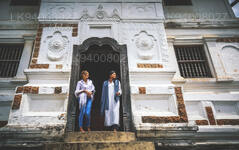
මහනුවර නගරය
මධ්යම ශ්රී ලංකාවේ දර්ශනීය නගරයක් වන මහනුවර, එහි පොහොසත් සංස්කෘතික උරුමයන්, සජීවී උත්සව සහ දර්ශනීය සුන්දරත්වය සඳහා ප්රසිද්ධය. සශ්රීක කඳු මුදුන් මැද පිහිටා ඇති එය, යුනෙස්කෝ ලෝක උරුම අඩවියක් වන දන්ත ධාතු මාලිගාවේ නිවහන වන අතර, ඉතිහාසයේ සහ ස්වභාවික තේජසෙහි ආකර්ශනීය මිශ්රණයක් ඉදිරිපත් කරයි.
The Last Kingdom Of Ceylon Kandy
The Kingdom of Kandy was a monarchy on the island of Sri Lanka, located in the central and eastern portion of the island. It was founded in the late 15th century and endured until the early 19th century.
Initially a client kingdom of the Kingdom of Kotte, Kandy gradually established itself as an independent force during the tumultuous 16th and 17th centuries, allying at various times with the Jaffna Kingdom, the Madurai Nayak dynasty of South India, Sitawaka Kingdom, and the Dutch colonizers to ensure its survival.
From the 1590s, it was the sole independent native polity on the island of Sri Lanka and through a combination of hit-and-run tactics and diplomacy kept European colonial forces at bay, before finally falling under British colonial rule in 1818.
The kingdom was absorbed into the British Empire as a protectorate following the Kandyan Convention of 1815, and definitively lost its autonomy following the Uva Rebellion of 1817.
Over the years, the Kingdom of Kandy has been known by many names.
- Kanda Uda Pasrata
- The Senkadagala Kingdom
- The Kanda Udarata
- The Mahanuwara Kingdom
- Sri Wardhanapura
- Sinhalé
- Thun Sinhalaya or Tri Sinhala
- Kande Nuwara
- The Kingdom of Kandy
Much of the Kandy Kingdom's territory was located in Sri Lanka's mountainous and thickly forested interior, with mountain passes to the capital providing plenty of opportunities for defenders to stage ambushes. Routes to the city were kept secret, and spreading information concerning them could often result in death. Many routes into the hill country became impassable during the annual monsoon, and malaria was rife. Throughout its existence Kandyan forces used the land to their advantage, engaging in guerrilla warfare against invading forces,[8] and evacuating major urban centres when enemy forces drew near – a tactic used with particular effect during the Kandyan Wars. Though the kingdom had intermittent access to the port of Batticaloa it had no naval forces and could not prevent the Portuguese and Dutch maintaining a strong presence in lowland areas.
The city of Senkadagalapura may have been founded as early as the mid-14th century during the reign of Vikramabahu III of Gampola (1357–1374). Central Sri Lanka was ruled by the kings of Kotte from the early 15th to late 16th centuries; with Kotte's weakening in the face of Portuguese influence the area developed into an autonomous domain with Senkadagalapura at its capital. Following the Spoiling of Vijayabahu in 1521, and the subsequent partition of the kingdom of Kotte, Kandy asserted its independence and emerged as a serious rival to the eastern and southern kingdoms.
මහනුවර දිස්ත්රික්කය ගැන
මහනුවර දිස්ත්රික්කය ශ්රී ලංකාවේ මධ්යම පළාතේ පිහිටා ඇත. ශ්රී ලංකාවේ ලෝක උරුම ස්ථාන හතෙන් එකක් වන මහනුවර, 16 වන සියවසේ උඩරට රජවරුන්ගේ නිවහන වූ අතර රටේ සියලුම සංගීතය, කලා, ශිල්ප සහ සංස්කෘතිය සඳහා උල්පතක් විය. කොළඹ සිට කිලෝමීටර් 129 ක් පමණ දුරින් පිහිටි මහනුවර කඳුකර භූමි ප්රදේශයක් අතර පිහිටා ඇති අතර සියලු දෙනාගේම ඇස් නගර මධ්යයට ඇදී යයි, එහිදී මහනුවර වැව ආකර්ශනීය ලක්ෂණයක් සාදයි. මහනුවර ශ්රී ලංකාවට විශාල ආගමික වැදගත්කමක් දරන්නේ, මෙම ආකර්ශනීය නගරයේ දළදා මාලිගාව හෝ "දන්ත ධාතුව" පිහිටා ඇති අතර, එහි බුදුරජාණන් වහන්සේගේ පූජනීය දන්ත ධාතුව හොඳින් ආරක්ෂා කර ඇත. රාජකීය උද්භිද උද්යානය, පේරාදෙණිය, පේරාදෙණිය නගර මධ්යයේ සිට කිලෝමීටර් 5 ක් පමණ බටහිරින් පිහිටා ඇති අතර වසරකට මිලියන 1.2 ක ජනතාවක් එය නරඹති. එය දිවයිනේ විශාලතම උද්භිද උද්යානයයි. උඩවත්ත කැලේ (උඩවත්ත වනාන්තරය) යනු නගර මධ්යයේ, දළදා මාලිගාවට උතුරින් පිහිටි ආරක්ෂිත අභයභූමියකි. මහනුවර සිංහල බහුතරයක් වෙසෙන නගරයකි; මුවර්ස් සහ දෙමළ වැනි අනෙකුත් ජනවාර්ගික කණ්ඩායම්වලට අයත් සැලකිය යුතු ප්රජාවන් එහි සිටිති. ශ්රී ලංකා ආර්ථිකයේ කේන්ද්රස්ථානය වන කොළඹට පමණක් මහනුවර දෙවැනි වේ. බොහෝ ප්රධාන සමුපකාර ව්යාපාරවල මහනුවර විශාල ශාඛා නිලධාරීන් සිටින අතර රෙදිපිළි, ගෘහ භාණ්ඩ, තොරතුරු තාක්ෂණය සහ ස්වර්ණාභරණ ඇතුළු බොහෝ කර්මාන්ත මෙහි දක්නට ලැබේ. බොහෝ කෘෂිකාර්මික පර්යේෂණ මධ්යස්ථාන නගරයේ පිහිටා ඇත. රටේ සියලුම සංගීතය, කලා, ශිල්ප සහ සංස්කෘතිය සඳහා උල්පතකි. කොළඹ සිට කිලෝමීටර් 129 ක් පමණ දුරින් පිහිටි මහනුවර කඳුකර භූමි ප්රදේශයක් අතර පිහිටා ඇති අතර සියලු දෙනාගේ ඇස් නගර මධ්යයට යොමු වේ, එහිදී මහනුවර වැව ආකර්ශනීය ලක්ෂණයක් සාදයි. ශ්රී ලංකාවට මහනුවර විශාල ආගමික වැදගත්කමක් රඳවා තබා ගන්නේ මෙම ආකර්ශනීය නගරයේ දළදා මාලිගාව හෝ දන්ත දේවාලය පිහිටා ඇති අතර එහි බුදුරජාණන් වහන්සේගේ පූජනීය දන්ත ධාතුව හොඳින් ආරක්ෂා කර ඇත.
මධ්යම පළාත ගැන
ශ්රී ලංකාවේ මධ්යම පළාත ප්රධාන වශයෙන් කඳුකර භූමි ප්රදේශයකින් සමන්විත වේ. පළාතේ භූමි ප්රමාණය කිලෝමීටර 5,674 ක් වන අතර ජනගහනය 2,421,148 කි. මහනුවර, ගම්පොල (24,730), නුවරඑළිය සහ බණ්ඩාරවෙල සමහර ප්රධාන නගර වේ. ජනගහනය සිංහල, දෙමළ සහ මුවර්ස් මිශ්රණයකි. කඳුකර අගනුවර වන මහනුවර සහ නුවරඑළිය නගරය යන දෙකම මධ්යම පළාත තුළ මෙන්ම ශ්රී පාදය තුළ පිහිටා ඇත. පළාතේ කෝපි වගාවන් විනාශකාරී රෝගයකින් විනාශ වීමෙන් පසු 1860 ගණන්වල බ්රිතාන්යයන් විසින් රෝපණය කරන ලද ප්රසිද්ධ ලංකා තේ වලින් වැඩි ප්රමාණයක් පළාත විසින් නිෂ්පාදනය කරනු ලැබේ. මධ්යම පළාත බොහෝ සංචාරකයින් ආකර්ෂණය කර ගන්නා අතර, මහනුවර, ගම්පොල, හැටන් සහ නුවරඑළිය වැනි කඳුකර නගර ඇත. පන්සල් දළදා මාලිගාව යනු සෙන්ට්රල් පළාතේ ප්රධාන පූජනීය ස්ථානයයි. දේශගුණය සිසිල් වන අතර මීටර් 1500 ක් පමණ උස බොහෝ ප්රදේශ බොහෝ විට සීතල රාත්රීන් ඇත. බටහිර බෑවුම් ඉතා තෙත් වන අතර සමහර ස්ථානවල වසරකට මි.මී. 7000 කට ආසන්න වර්ෂාපතනයක් ලැබේ. නැගෙනහිර බෑවුම් මධ්යම වියළි කලාපයේ කොටස් වන අතර එයට වැසි ලැබෙන්නේ ඊසානදිග මෝසමෙන් පමණක් වන බැවිනි. මහනුවර උෂ්ණත්වය සෙල්සියස් අංශක 24 සිට මුහුදු මට්ටමේ සිට මීටර් 1,889 ක් ඉහළින් පිහිටි නුවරඑළියේ අංශක 16 දක්වා පරාසයක පවතී. ශ්රී ලංකාවේ උසම කඳු මධ්යම පළාතේ පිහිටා ඇත. භූමි ප්රදේශය බොහෝ දුරට කඳුකර වන අතර ගැඹුරු නිම්න එයට කපා ඇත. ප්රධාන කඳු කලාප දෙක වන්නේ මධ්යම කඳු පන්තිය සහ මහනුවර නැගෙනහිරින් පිහිටි නකල්ස් පරාසයයි.


























